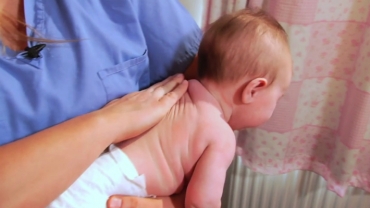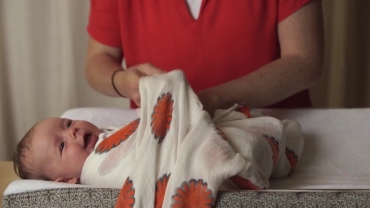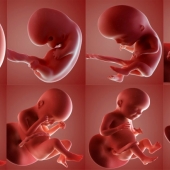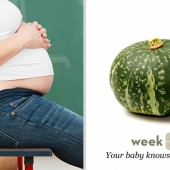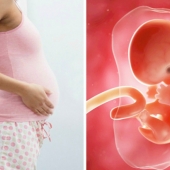Month 1 - At this point the baby is developing the structures that will eventually form his face and neck. The heart and blood vessels will continue to develop. And thr lungs, stomach, and liver start to develop. A home pregnancy test would show positive.
Month 2 - The baby is now a little over half an inch in size. Eyelids and ears are forming, and you can see the tip of the nose. The arms and legs are well formed. The fingers and toes grow longer and more distinct.
Month 3 - The baby measures about 2 inches and starts to make its own movements. You may start to feel the top of your uterus above your pubic bone. Your doctor may hear the baby's heartbeat with special instruments. The sex organs of the baby should start to become clear.
Month 4 - The baby now measures about 4.3 to 4.6 inches and weighs about 3.5 ounces. You should be able to feel the top of your uterus about 3 inches below your belly button. The baby's eyes can blink and the heart and blood vessels are fully formed. The baby's fingers and toes have fingerprints.
Month 5 - The baby weighs about 10 ounces and is a little more than six inches long. Your uterus should be at the level of your belly button. The baby can suck a thumb, yawn, stretch, and make faces. Soon - if you haven't already - you'll feel your baby move, which is called "quickening." An ultrasound is usually done for all pregnant women at 20 weeks. During this ultrasound, the doctor will make sure that the placenta is healthy and attached normally and that your baby is growing properly. You can see the baby's heartbeat and movements of its body, arms, and legs on the ultrasound. You can usually find out whether it's a boy or a girl at 20 weeks.
Month 6 - The baby weighs about 1.4 pounds now and can respond to sounds by, moving or increasing his pulse. You may notice jerking motions if he hiccups. With the inner ear fully developed, the baby may be able to sense being upside down in the womb.
Month 7 - The baby weighs about 2 pounds, 6 ounces, and changes position often at this point in the pregnancy. If you had to deliver prematurely now, there is a good chance the baby would survive. Ask your doctor about preterm labor warning signs. Now is the time to register for birthing classes. Birthing classes prepare you for more aspects of childbirth, including labor and delivery and taking care of your newborn.
Month 8 - The baby weighs almost 4 pounds and is moving around often. The baby's skin has fewer wrinkles as a layer of fat starts to form under the skin. Between now and delivery, your baby will gain up to half his birth weight. Ask your doctor how to do a fetal movement chart. Think about breastfeeding. You may notice a yellowish fluid leaking from your breasts. That is colostrum, and it happens to get your breasts ready for making milk. Most women go to the doctor every two weeks at the stage of pregnancy.
Month 9 - Babies differ in size, depending on many factors, such as gender, the number of babies being carried, and the size of the parents. So your baby's overall rate of growth is as important as the actual size. On average, a baby at this stage is about 18.5 inches and weighs close to 6 pounds. The brain has been developing rapidly. Lungs are nearly fully developed. The head is usually positioned down into the pelvis by now. Your baby is considered at 'term' when he is 37 weeks. He is an early term baby if born between 37-39 weeks, if he's 39-40 weeks and late term if he's 41-42 weeks.
- 18379 views




